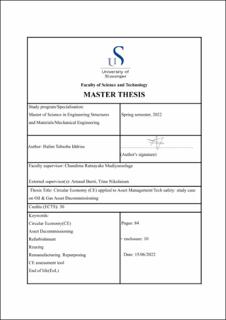| dc.description.abstract | The CE has been fast erupting in terms of its relevance. It has tried to be implemented to achieve sustainable development and most importantly, reap economic benefits since it is reflected as attractive for business but it has not been implemented to its full potential.
Due to a lack of awareness and understanding of the impacts of CE, theoretical knowledge was gathered and it was necessary to do a literature review. A question-based survey was conducted as well; however, the survey findings were inconclusive as a result of insufficient participants.
As a case study, a further study was discussed on oil and gas asset decommissioning and how it is impacted by the CE. Considering the numerous years an oil and gas project could be running, the field production eventually ends after which the assets or equipment on the platform will have to be removed. A lot of materials are obtained in this phase of the oil and gas projects. An amount of the platform structures and equipment offshore are transported to onshore where a good amount is recycled, and the rest is being disposed of in landfills as scrubs. These practices are not environmentally and economically friendly and therefore the Circular Economy comes in to save the day by various methods such as refurbishment, reusing, remanufacturing and repurposing rather than abandoning the equipment or just recycling.
Another aspect of the thesis was mainly on developing a CE assessment tool. The CE assessment tool was built based on literature and theoretical knowledge gathered. It was focused on the decommissioning phase of the assets where the End of life(EoL) stage has been reached. Two study cases or examples were used to demonstrate the two functionalities of the CE assessment tool. Other functionalities of the tool were summarised as well.
Finally, a product development process framework in terms of the CE applied to equipment/product in their EoL phase was developed.It was developed on basis of a generic product development process consisting of six phases and based on CE concepts and theoretical knowledge. The objective of the framework is to be able to have a structured plan for when products are to be looped into the CE when they reach their EoL phase to extend their life. | |
